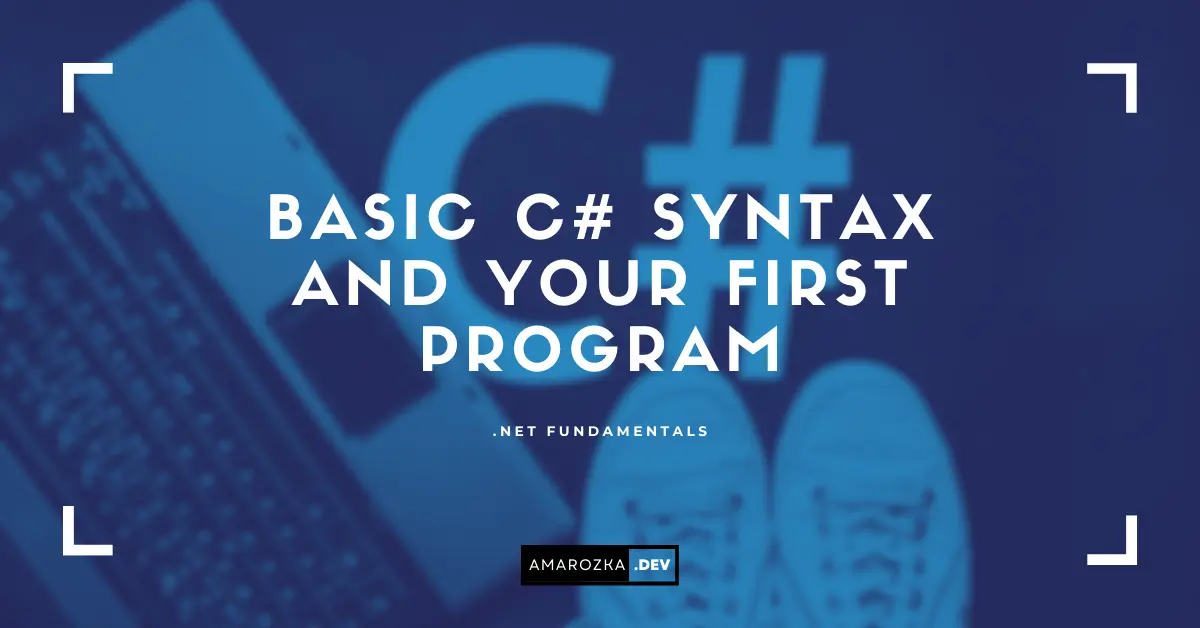Embarking on the journey to learn C# programming begins with understanding its basic C# syntax and crafting your very first program. This topic will provide a gentle introduction, ensuring you grasp the foundational elements of the language, its conventions, and the steps to write and run a rudimentary application.
Structure of a C# Program
Let’s delve deeper into the foundational structure of a C# program by crafting a detailed walkthrough. We’ll utilize a tangible example: the development of a straightforward system to manage the inventory of books in a library. This will offer a hands-on illustration of various facets of a C# application.
Using Directives:
Before writing actual code, it’s standard practice to include references to libraries or namespaces. These references, known as ‘using directives’, give access to a myriad of functionalities and types, streamlining the coding process by eliminating the need for verbose namespace specifications.
using System;
using System.Collections.Generic;In our library example, we need basic functionalities (from System) and a way to maintain lists (from System.Collections.Generic).
Namespace Declaration:
A namespace serves as a container, grouping related types, much like a folder on a computer. By categorizing classes and other type members under a namespace, we maintain an organized structure and reduce name collisions.
namespace LibraryInventorySystem
{
// Subsequent class and type declarations go here.
}Our library system resides in the LibraryInventorySystem namespace.
Class Declaration:
Within namespaces, we define classes. Think of a class is a blueprint or prototype from which objects are created. Each class encapsulates data (attributes) and behavior (methods).
For our system, we’ll start with a Book class:
public class Book
{
// Fields, properties, methods follow.
}Attributes and Behavior (Fields, Properties, Methods):
Within our Book class, we represent attributes (like title and author) with fields and properties. Methods capture the behavior of class. For example display book information.
private string title; // Field
public string Title // Property
{
get { return title; }
set { title = value; }
}
public void DisplayInfo() // Method
{
Console.WriteLine($"Title: {title}");
}Constructors:
A constructor in C# is a special method that gets automatically invoked when an object of a class is instantiated. For our Book class, a constructor can be used to set the initial state of a book, such as its title and author.
public Book(string title)
{
this.title = title;
}Main Method – The Program’s Entry Point:
The Main method acts as the gateway to the program. The C# runtime looks for this method to initiate the program’s execution.
For our library system:
public class Program
{
public static void Main(string[] args)
{
// Code to demonstrate the library system goes here.
}
}Bringing It All Together:
To tie our library system together, we can add a Library class to manage multiple books, instantiate book objects, add them to the library, and then display them.
public class Library
{
private List<Book> books = new List<Book>();
public void AddBook(Book book) => books.Add(book);
public void DisplayBooks() => books.ForEach(book => book.DisplayInfo());
}
// Inside the Main method:
Library myLibrary = new Library();
myLibrary.AddBook(new Book("1984"));
myLibrary.AddBook(new Book("Brave New World"));
myLibrary.DisplayBooks();This structured walk-through showcases the fundamental building blocks of a C# program, using a library inventory system as a hands-on example. By understanding these basics, you’ll have a solid foundation for diving deeper into C# programming.
Writing a Simple C# Program
Let’s see fully a simple program for managing a library book inventory to understand structure of C# program.
// Using Directives
using System;
using System.Collections.Generic;
// Namespace Declaration
namespace LibrarySystem
{
// Class to represent a book
public class Book
{
// Field Declarations
private string title;
private string author;
private bool isAvailable;
// Property Declarations
public string Title
{
get { return title; }
set { title = value; }
}
public string Author
{
get { return author; }
set { author = value; }
}
public bool IsAvailable
{
get { return isAvailable; }
set { isAvailable = value; }
}
// Constructor
public Book(string title, string author)
{
this.title = title;
this.author = author;
this.isAvailable = true; // By default, a book is available
}
// Method to Display Book Info
public void DisplayInfo()
{
Console.WriteLine($"Title: {title}, Author: {author}, Available: {isAvailable}");
}
}
// Class to manage the library
public class Library
{
private List<Book> books = new List<Book>();
// Method to Add Book
public void AddBook(Book book)
{
books.Add(book);
}
// Method to List All Books
public void DisplayBooks()
{
foreach (var book in books)
{
book.DisplayInfo();
}
}
}
// Main Program Class
public class Program
{
public static void Main(string[] args)
{
// Create a new library instance
Library myLibrary = new Library();
// Add books to the library
myLibrary.AddBook(new Book("1984", "George Orwell"));
myLibrary.AddBook(new Book("Brave New World", "Aldous Huxley"));
myLibrary.AddBook(new Book("To Kill a Mockingbird", "Harper Lee"));
// List all books in the library
myLibrary.DisplayBooks();
}
}
}When you run this program, you should get the following output:
Title: 1984, Author: George Orwell, Available: True
Title: Brave New World, Author: Aldous Huxley, Available: True
Title: To Kill a Mockingbird, Author: Harper Lee, Available: TrueIn this example:
- We used
usingdirectives for namespaces we needed. - We declared a namespace
LibrarySystemto organize our code. - We created two classes
BookandLibrary. - We used fields, properties, and methods in the
BookandLibraryclasses. - The
Mainmethod in theProgramclass serves as the entry point of our application. - We instantiated objects, set their properties, and invoked methods.
This is a basic representation of how components fit together in a typical C# program.
Understanding Namespaces, Classes, and Methods
After you start learning C# programming, you quickly realize the importance of having a well-organized and clear code structure. As we explore this extensive programming language, there are three main components that are crucial for understanding and coding in C#. This section aims to provide a detailed explanation of these parts, helping readers gain a clear understanding of the main aspects of C# programming.
Basic C# Syntax Of Namespaces
In C#, a namespace is a way to organize related classes and other types, giving you a way to avoid conflicts between type names.
Purpose:
- Organization: Group related classes or types.
- Avoid Naming Collisions: If two developers create a
Userclass, they can be differentiated by their namespaces.
Example:
namespace Company.Project.Module
{
// Classes and types go here
}Usage:
- When using a type from another namespace, you can either use its fully qualified name:
Company.Project.Module.MyClass obj = new Company.Project.Module.MyClass();- Or use the
usingdirective at the beginning of your file to simplify references:
using Company.Project.Module;
// Later in the code
MyClass obj = new MyClass();It’s common to see nested namespaces:
namespace Company.Project
{
namespace Module
{
// Classes and types go here
}
}Basic C# Syntax Of Classes
A class in C# defines the blueprint for an object, encapsulating data (in the form of fields) and behaviors (in the form of methods).
Structure:
- Fields: Variables that store object data.
- Properties: Mechanism to read, write, or compute the value of a private field.
- Methods: Functions that operate on object data and perform specific actions.
Example:
public class Person
{
private string name; // Field
// Property
public string Name
{
get { return name; }
set { name = value; }
}
// Method
public void Introduce()
{
Console.WriteLine("Hi, my name is " + name);
}
}Instantiation:
After you’ve defined a class, you can create objects (or instances) of that class:
Person person1 = new Person();
person1.Name = "Alice";
person1.Introduce(); // Outputs: "Hi, my name is Alice"Basic C# Syntax Of Methods
A method is a code block containing a series of statements that perform a specific task. Methods are defined inside classes or structs.
Structure:
- Access Modifier: Determines the visibility of the method (e.g.,
public,private). - Return Type: The type of value the method returns. If a method doesn’t return a value, the type is
void. - Method Name: A unique identifier.
- Parameters: Values passed into the method.
Example:
public int Add(int a, int b)
{
return a + b;
}Usage:
int result = Add(5, 3); // result will be 8Basic C# Syntax Of Method Overloading:
You can have multiple methods in the same class with the same name and different parameters. This is called method overloading.
public void Display(string message) { /*...*/ }
public void Display(string message, int times) { /*...*/ }Summary
- Namespaces are a way to organize and group your code.
- Classes allow you to define blueprints for objects, which contain data and behavior.
- Methods provide the behavior for classes, defining actions that can be performed.
Understanding these concepts thoroughly is fundamental for any C# developer, as they form the backbone of the language and provide the structure for building robust applications.
FAQ
A basic C# program includes using directives (for referencing namespaces), a namespace declaration (to organize code), and at least one class with a Main method, which is the program’s entry point.
The Main method is the entry point of a C# program. When the program is executed, the code inside the Main method runs first.
You can use the Console.WriteLine() method to display text or output on the console. For instance, Console.WriteLine("Hello, World!"); would display “Hello, World!” on the screen.
using directives allow you to reference types from other namespaces without specifying the full namespace path. For example, using System; lets you access classes and methods from the System namespace directly.
Variables in C# are declared by specifying a type followed by a name. For example, int myNumber = 10; declares a variable named myNumber of type int and assigns it a value of 10.
C# offers several built-in data types, including:
1. int for integers (e.g., int age = 25;)
2. double for floating-point numbers (e.g., double weight = 70.5;)
3. char for single characters (e.g., char letter = 'A';)
4. bool for boolean values (e.g., bool isTrue = false;)
5. string for sequences of characters (e.g., string name = "John";)
You can use the Console.ReadLine() method to get input from the user. To read numbers or other types, you may need to parse the input using methods like int.Parse().
In C#, you can use // for single-line comments and /* */ for multi-line comments.
Example:// This is a single-line comment /* This is a multi-line comment */
Yes, you can have multiple classes in a single file. For clarity and maintainability, it’s often recommended to have one class per file, with the file name matching the class name.
To compile a C# program, you can use the csc compiler that comes with the .NET SDK. For example, csc MyProgram.cs will compile a file named MyProgram.cs. Once compiled, you can run the program using the resulting executable, e.g., MyProgram.exe.
An Integrated Development Environment (IDE) is software that provides tools for coding, debugging, and testing. For C#, Visual Studio by Microsoft is a widely-used IDE that offers extensive features for C# development.




